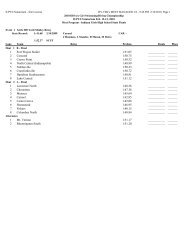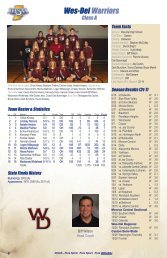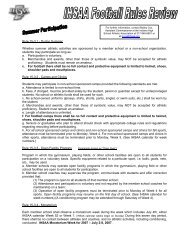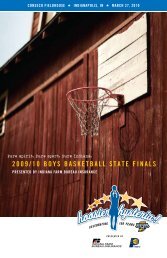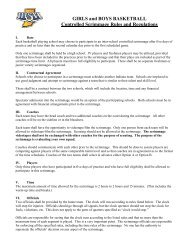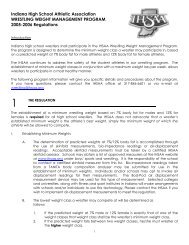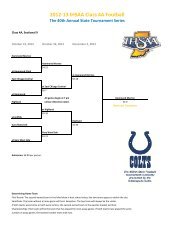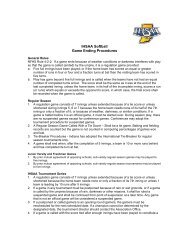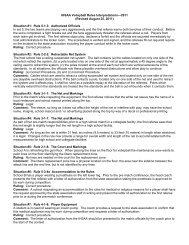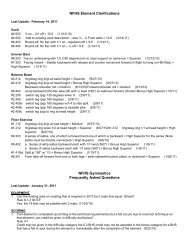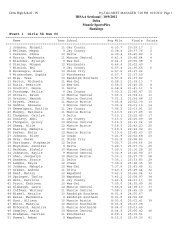Board of Directors - ihsaa
Board of Directors - ihsaa
Board of Directors - ihsaa
Create successful ePaper yourself
Turn your PDF publications into a flip-book with our unique Google optimized e-Paper software.
IHSAA <strong>Board</strong> <strong>of</strong> <strong>Directors</strong> Meeting Indianapolis, Indiana – May 2, 2011<br />
Roll Call<br />
President Phil DeLong, Nancy Alspaugh, Victor Bush, Steve Cox, Nathan Dean, Jim Diagostino, Phil Ford, Tim<br />
Grove, Ken Howell, Jed Jerrels, John Marks, Pam Noble, Ge<strong>of</strong>f Penrod, Janis Qualizza, Joe Santa, Debb Stevens,<br />
Deborah Watson, Mike Whitten, Commissioner Bobby Cox, Assistant Commissioners Robert Faulkens, Phil Gardner,<br />
Sandy Searcy, Theresia Wynns, Sports Information Director Jason Wille, Communications Director Chris Kaufman,<br />
and Attorney Bob Baker.<br />
Minutes<br />
A motion to approve the minutes <strong>of</strong> the May 3, 2010 meeting was made by Jim Diagostino; seconded by Ge<strong>of</strong>f<br />
Penrod; motion passed 18-0.<br />
Necrology Service<br />
John Bastin, age 89, <strong>of</strong> Richmond, died Friday, July 2, 2010, at Reid Hospital. He received his bachelors degree in<br />
1948 and masters degree in 1951 both from Indiana University. He received his Public School Superintendent’s<br />
License from Indiana University in 1954. John served his country during World War II in the Army Air Corps. He<br />
would later retire as a Major in the U.S. Air Force Reserve. He had been President <strong>of</strong> the IHSAA <strong>Board</strong> <strong>of</strong> Control<br />
during the 1969-1970 school year. John was a teacher and basketball coach at Hebron, Monticello, LaPorte and<br />
Richmond, Indiana. He was Assistant Principal at Union High School at Modoc and retired in 1985 as Assistant<br />
Principal <strong>of</strong> Centerville High School.<br />
PROPOSED CHANGES IN THE IHSAA BY-LAWS<br />
Proposals submitted by the Commissioner unless otherwise noted, to become effective immediately:<br />
Prop. # Rule, Section, Article<br />
Page<br />
1. Article III, Section 1 3<br />
Change: All Memberships Are Voluntary. Any secondary school in the state may become a member <strong>of</strong> this<br />
Corporation by meeting the requirements for membership, by subscribing to all <strong>of</strong> these rules and<br />
regulations <strong>of</strong> the Corporation, and by completing and submitting a membership application form to the<br />
Commissioner on or before September 1 <strong>of</strong> each year. Applications for membership by non-member schools<br />
must be accompanied with a one two thousand dollar initiation fee and must be received by the<br />
Commissioner no later than August 1.<br />
A motion to increase the IHSAA Membership application fee to two thousand dollars was made by Mike Whitten;<br />
seconded by Phil Ford; motion approved 18-0.<br />
2. Article III, Section 3 3<br />
Change: Any school upon being granted membership in the Association shall not be permitted to participate<br />
in IHSAA tournaments for a period <strong>of</strong> two four years from the date <strong>of</strong> admittance. NOTE: Existing IHSAA<br />
member schools who that consolidate or divide into multiple schools shall be excluded from said rule.<br />
A motion to increase the amount <strong>of</strong> time that a new member can enter the tournament series from two years to four<br />
years was made by John Marks; seconded by Janis Qualizza; motion approved 17-1, with Jim Diagostino dissenting.<br />
3. Article III, Section 4 4<br />
Junior membership may be extended to a school which is accredited by the Department <strong>of</strong> Education, which<br />
<strong>of</strong>fers ninth grade, but which is not eligible for full membership.<br />
A motion to eliminate superfluous language in this section so that most information is included in the Junior<br />
Membership By-law was made by Nathan Dean; seconded by Ge<strong>of</strong>f Penrod; motion approved18-0.<br />
1 | P age
4. Article IV, Section 3 5<br />
Change: a. The <strong>Board</strong> <strong>of</strong> <strong>Directors</strong> shall be comprised <strong>of</strong> nineteen board seats. Twelve board seats shall<br />
be filled by any qualified individual (open seats), and seven board seats shall be filled by two qualified<br />
female representatives, two qualified minorities, two qualified urban school representatives and one qualified<br />
private school representative. <strong>Board</strong>s <strong>of</strong> <strong>Directors</strong>’ elections are scheduled as follows:<br />
Election<br />
Date Term District I District II District III<br />
Dec. 2011 2012-15 Classes AA & AAAA Classes A & AAA Classes AA & AAAA<br />
Election<br />
Date Term Northern District Southern District State Wide<br />
Dec. 2012 2013-16 Female, Minority & Urban Seats Female, Minority & Urban Seats Private Seat<br />
Election<br />
Date Term District I District II District III<br />
Dec. 2013 2014-17 Classes A & AAA Classes AA & AAAA Classes A & AAA<br />
Dec. 2014 2015-18 Classes AA & AAAA Classes A & AAA Classes AA & AAAA<br />
Election<br />
Date Term Northern District Southern District State Wide<br />
Dec. 2015 2016-19 Female, Minority & Urban Seats Female, Minority & Urban Seats Private Seat<br />
Election<br />
Date Term District I District II District III<br />
Dec. 2016 2017-20 Classes A & AAA Classes AA & AAAA Classes A & AAA<br />
Dec. 2017 2018-21 Classes AA & AAAA Classes A & AAA Classes AA & AAAA<br />
Election<br />
Date Term Northern District Southern District State Wide<br />
Dec. 2018 2019-22 Female, Minority & Urban Seats Female, Minority & Urban Seats Private Seat<br />
A motion to revise and clarify the IHSAA Executive Committee election schedule was made by Steve Cox; seconded<br />
by Tim Grove; motion approved 18-0.<br />
5. Rule 2, Section 2 15<br />
The <strong>Directors</strong> have complete authority to establish and implement policies to determine the number <strong>of</strong><br />
classes and the number <strong>of</strong> schools in each class <strong>of</strong> competition in team sports. The following is the<br />
customary manner for classifying schools:<br />
In team sports, the total schools participating shall be divided as follows:<br />
a. If there are two classes — 1A=50% <strong>of</strong> schools; 2A=50% <strong>of</strong> schools.<br />
b. If there are three classes — 1A=33 1 / 3 % <strong>of</strong> schools; 2A=33 1 / 3 % <strong>of</strong> schools; 3A=331/3 % <strong>of</strong> schools.<br />
c. If there are four classes — 1A=25% <strong>of</strong> schools; 2A=25% <strong>of</strong> schools; 3A=25% <strong>of</strong> schools; 4A=25% <strong>of</strong><br />
schools.<br />
d. If there is one more school than equal division, that school may be placed in the smallest class.<br />
e. If there are two more schools than equal division, those schools may be placed one each in the smaller<br />
two classes.<br />
f. If there are three more schools than equal division, those schools may be placed one each in the<br />
smallest three classes.<br />
A motion to reaffirm and adopt this Emergency By-Law adopted by Executive Committee at the June 24, 2010<br />
Executive Committee Meeting was made by Steve Cox; seconded by Mike Whitten; motion approved 18-0.<br />
6. Rule 2, Section 3 16<br />
2 | Page
School enrollment figures used for classifying schools shall be the enrollment in grades 9-12 for all students,<br />
as certified in the annual report filed with the State Department <strong>of</strong> Education in a classification year.<br />
a. Schools with single gender enrollment shall double the certified enrollment figures for classification<br />
purposes.<br />
b. A school may be assigned to different classes in different sports.<br />
c. A school shall be assigned to a class by the IHSAA and shall enter the IHSAA tournament in that<br />
assigned class unless it notifies the Association, in writing, that it wishes to move up one or more<br />
classes. This notification shall (1) accompany the submission <strong>of</strong> the school’s enrollment figures and (2)<br />
be effective for the succeeding two years. A school may choose to move up in a specific sport/s.<br />
A motion to reaffirm and adopt this Emergency By-Law adopted by Executive Committee at the June 24, 2010<br />
Executive Committee Meeting was made by Phil Ford; seconded by Debb Stevens; motion approved 18-0.<br />
7. Rule 3, Section 10 18<br />
Change: Between May 1 April 1 and student’s first practice in preparation for interschool athletic<br />
participation:<br />
A motion to change the annual date <strong>of</strong> the pre-participation physical examination and consent form one month earlier<br />
was made by Nancy Alspaugh; seconded by Jim Diagostino; motion approved 18-0.<br />
8. Rule 7, Section 1, Article 4 28<br />
Change: c. The Commissioner may approve requests for additional five (5) year extensions <strong>of</strong> a waiver for a<br />
basketball head coach or a football head coach, provided the Commissioner has been provided pro<strong>of</strong> that<br />
the coach, during the prior waiver period, has successfully completed at least six (6) hours <strong>of</strong> college credit<br />
two additional in IHSAA approved education coaching courses.<br />
A motion to clarify language that describes requirements for coaching education was made by Steve Cox; seconded<br />
by John Marks; motion approved 18-0.<br />
9. Rule 15, Section 3, Article 3 48<br />
Member schools may operate open facility programs in which the gymnasium, playing field or other school<br />
facilities are open to all students for participation on a voluntary basis, but only for a student who (i) attends<br />
the school, (ii) is from a feeder school and intends to attend the school, or (iii) is a transfer student or an<br />
incoming 9 th grade student from a non-feeder school who intends to attend the school and has confirmed<br />
such intention with the school’s principal or school administration, and has either enrolled or has applied for<br />
admission and has paid a deposit. Under any circumstance, a student may attend open facilities at no more<br />
than one school.<br />
A motion to reaffirm and adopt this Emergency By-Law adopted by Executive Committee at the June 24, 2010<br />
Executive Committee Meeting was made by Ge<strong>of</strong>f Penrod; seconded by Jim Diagostino; motion approved 18-0.<br />
10. Rule 17, Section 5, Article 1 57<br />
When a decision has been made and/or a penalty has been imposed by the Committee, or by a principal or<br />
the Commissioner, or his designee and an appeal has not timely been sought, there shall be no review<br />
there<strong>of</strong> except upon a showing <strong>of</strong> newly discovered evidence, which by due diligence could not have been<br />
timely presented and which is directly related to the findings in the case, or that there was fraud,<br />
misrepresentation or other misconduct <strong>of</strong> a party or witness, or that there was a prejudicial error in the<br />
procedure that was followed in the processing <strong>of</strong> the case.<br />
A motion to reaffirm and adopt this Emergency By-Law adopted by Executive Committee at the June 24, 2010<br />
Executive Committee Meeting was made by Tim Grove; seconded by Janis Qualizza; motion approved 18-0.<br />
3 | P age
11. Rule 17, Section 8, Article 1 58<br />
Except with respect to Rules 4, 12 and 18, the Commissioner, his designee, the Review Committee or the<br />
Case Review Panel shall have the authority to set aside the effect <strong>of</strong> any Rule and grant a general waiver<br />
when the affected party establishes, by clear and convincing evidence, and to the reasonable satisfaction <strong>of</strong><br />
the Commissioner, his designee, the Review Committee or the Case Review Committee, that all <strong>of</strong> the<br />
following conditions are met:<br />
a. Strict enforcement <strong>of</strong> the Rule in the particular case will not serve to accomplish the primary purposes <strong>of</strong><br />
the Rule;<br />
b. The spirit or reason for the Rule will not be <strong>of</strong>fended or compromised by a waiver;<br />
c. Unless waived, an undue harm or burden will be suffered by the affected party from enforcement <strong>of</strong> the<br />
Rule; and<br />
d. When a student eligibility waiver is requested, a hardship condition, as defined in Rule 17-8.3 exists.<br />
12. Rule 17, Section 8, Article 2 58<br />
An affected party shall apply for a general waiver at the time a matter is referred to the Association under<br />
Rule 17-2.4 or Rule 17-2.5 or, if the matter is not so referred, during the investigation, but prior to a decision,<br />
under Rule 17-3; for good cause shown or because <strong>of</strong> circumstances outside the control <strong>of</strong> the affected<br />
party, an affected party may seek a general waiver during the review process under Rule 17-4 for the first<br />
time. Under any circumstance, however, the appropriate time for a general waiver application is when the<br />
grounds for the waiver are discovered.<br />
a. In bringing a general waiver request, an affected party shall make application in a writing which shall<br />
contain all facts pertaining to the case, including sufficient data to make it possible to reach a decision<br />
without further investigation. All correspondence and documents pertinent to the case shall be<br />
submitted.<br />
b. Requests for a general waiver should always be made prior to any action or participation by the student,<br />
coach, school or affected party under circumstances which would constitute either ineligibility or a Rule<br />
or decision violation.<br />
13. Rule 17, Section 8, Article 3 59<br />
A student seeking a student eligibility general waiver must show the existence <strong>of</strong> a hardship condition. A<br />
“hardship condition” means a extremely negative non-athletic condition, peculiar to the student, which is<br />
caused by unforeseen, unavoidable and uncorrectable events, which is beyond the election, control or<br />
creation <strong>of</strong> the student, the student’s family, the student’s supporters, the student’s coaches and the<br />
student’s school, and which causes the student to be ineligible or not fully eligible, or which objectively<br />
compels some action which results in the student being ineligible or results in the student not having full<br />
eligibility. A student eligibility general waiver is exceptional and extraordinary relief, granted in rare cases;<br />
ordinary cases shall not qualify for a student general eligibility waiver.<br />
a. Likewise, a negative change in the financial condition <strong>of</strong> the student or a student’s family may constitute<br />
a hardship condition, however, such change must be permanent, substantial and significantly beyond<br />
the control <strong>of</strong> the student or the student’s family.<br />
b. In a transfer case where a student seeks full or limited eligibility, and there is evidence that the transfer<br />
or move was motivated, in part, by athletic reasons, albeit not for primarily athletic reasons, the student<br />
will not qualify for a general waiver.<br />
c. In any application for a hardship under this Rule 17-8, the burden is upon the party seeking the<br />
hardship, whether it is a student, school or affected party, to show entitlement to a hardship by clear<br />
and convincing evidence.<br />
14. Rule 17, Section 8, Article 4 59<br />
When the circumstances do not directly relate to student eligibility, an affected party may request a general<br />
waiver when special circumstances arise that call for relief from, or modification <strong>of</strong>, the effects <strong>of</strong> a Rule,<br />
policy or procedure on an affected party.<br />
4 | P age
15. Rule 17, Section 8, Article 5 59<br />
Limited Eligibility Waiver<br />
16. Rule 17, Section 9 59<br />
Eight Semester Eligibility Waiver<br />
A motion to approve amendments 11 through 16 which clarify the criteria upon which an affected party may obtain a<br />
‘general waiver’ in an eligibility case was made by Phil Ford; seconded by Tim Grove; motion approved 18-0.<br />
(Submitted by James Diagostino, Principal, Tri-West Hendricks High School)<br />
17. Rule 18, Section 8 65<br />
Change: High school students who are enrolled in a member high school may, with prior written approval <strong>of</strong><br />
their high school principal, obtain credits from alternative courses which may count toward IHSAA scholastic<br />
eligibility requirements:<br />
a. Colleges: A student may attend an accredited institution or another high school for credit that is<br />
acceptable both for high school graduation and college credit. The student must be enrolled in credit<br />
courses at their home school at least 50% <strong>of</strong> the normal school day and be enrolled in and passing enough<br />
credit courses to meet the minimum academic standards for eligibility. In determining credits, three semester<br />
hours or the equivalent shall be counted as equivalent <strong>of</strong> one three high school credit(s).<br />
NOTE: An accredited institution is one that grants credits which count toward a baccalaureate degree from<br />
that institution.<br />
A motion to amend the rule to read …three semester hours or the equivalent shall be counted shall be counted as <strong>of</strong><br />
one high school credit(s) was made by Jim Diagostino; seconded by Tim Grove; motion approved 17-1, with Deborah<br />
Watson dissenting.<br />
A motion to amend the proposal to state: A student may attend an accredited institution or another high school for<br />
credit that is acceptable both for high school graduation and college credit. The student must attend one full credit<br />
(DOE approved course) at the home high school, and passing enough credit courses to meet the minimum academic<br />
standards for eligibility. In determining credits, three semester hours or the equivalent shall be counted as equivalent<br />
<strong>of</strong> one high school credit(s), was made by Steve Cox; seconded by Tim Grove; motion failed 5-13, with Nancy<br />
Alspaugh, Ken Howell, Tim Grove, Nathan Dean, Steve Cox voting to approve.<br />
A motion to table the proposal was made by Jim Diagostino; seconded by Tim Grove; motion approved 18-0.<br />
18. Rule 19, Section 1 70<br />
When a student is promoted from grade 8, such student may enter grade 9, and have full eligibility, in a<br />
school <strong>of</strong> such student’s choice provided:<br />
a. such student enrolls on or before the 15th initial school day at such school; and<br />
b. Rule C–20 - Undue Influence has not been violated.<br />
In the event a student attends a junior high or middle school which includes grade 9, full eligibility shall be at<br />
the parent high school in grade 10.<br />
A motion to approve this amendment which clarifies that a student who matriculates to 9 th grade from 8 th grade will<br />
have full athletic eligibility at the school at the student’s choosing was made by Mike Whitten; seconded by Jim<br />
Diagostino; motion approved 18-0.<br />
19. Rule 19, Section 2 70<br />
Once a student obtains full athletic eligibility in a school, such student retains full athletic eligibility in that<br />
school even though such student’s parent(s)/guardian(s) or the student moves to another district or territory,<br />
however, such full athletic eligibility is forfeited in such school in the event:<br />
a. the student enrolls at and attends another school for fifteen (15) or more school days; or<br />
b. such student participates in an interschool contest as a representative <strong>of</strong> another school; or<br />
5 | Page
c. the student obtained full eligibility under the foreign exchange student exception, 19-6.1(m), and<br />
the student continued in attendance at the member school after the initial year <strong>of</strong> eligibility.<br />
A motion to approve this proposal clarifying that a student who remains enrolled at a school retains full athletic<br />
eligibility at that school until the student’s enrollment changes was made by Jim Diagostino; seconded by Phil Ford;<br />
motion approved 18-0.<br />
20. Rule 19, Section 3 71<br />
A student who transfers to a member school shall be ineligible to participate in interschool athletics for a<br />
period <strong>of</strong> 365 days after enrollment, unless and until an IHSAA Athletic Transfer Report shall have been<br />
ruled on by the Commissioner, or the Commissioner’s designee.<br />
A motion to approve this amendment which clarifies that a transfer student who enrolls at a new school is athletically<br />
ineligible at the new school until a Transfer Report is ruled upon by the IHSAA Commissioner was made by Ge<strong>of</strong>f<br />
Penrod; seconded by Pam Noble; motion approved 18-0.<br />
21. Rule 19, Section 4 71<br />
19-4 Transfer For Primarily Athletic Reasons or the Result <strong>of</strong> Undue Influence.<br />
To preserve the integrity <strong>of</strong> interschool athletics and to prevent or minimize recruiting, proselytizing and<br />
school ‘jumping’ for athletic reasons, regardless <strong>of</strong> the circumstances, a student athlete who transfers from<br />
one school to a new school for primarily athletic reasons or as a result <strong>of</strong> undue influence will be ineligible at<br />
the new school for 365 days from the date the student enrolls at the new school. However, if a student<br />
transfers and it is not discovered at that time that the transfer was primarily for athletic reasons or the result<br />
<strong>of</strong> undue influence, then the student will be ineligible for 365 days commencing on the date that the<br />
Commissioner or Commissioner’s designee rules the student ineligible.<br />
A motion to approve this amendment which clarifies that a student who transfers for primarily athletic reasons or as a<br />
result <strong>of</strong> undue influence will be athletically ineligible at the new school for 365 days from the date <strong>of</strong> the student’s<br />
enrollment, or for 365 days from the date the IHSAA rules the student athletically ineligible, was made by Tim Grove;<br />
seconded by Phil Ford; motion approved 18-0.<br />
22. Rule 19, Section 5 71<br />
A student who transfers with a corresponding change <strong>of</strong> residence to a new district or territory by the<br />
student’s custodial parent(s)/guardian(s) will have full eligibility at the new school, provided there is a bona<br />
fide change <strong>of</strong> residence, provided neither the residential change nor the selection <strong>of</strong> the new residence<br />
was the result <strong>of</strong> primary athletic reasons or the result <strong>of</strong> undue influence, and provided the transfer is not for<br />
primarily athletic reasons or the result <strong>of</strong> undue influence.<br />
A motion to approve the proposal clarifying that a student who transfers with a corresponding change <strong>of</strong> residence by<br />
the parents/guardians to a new district or territory will have full athletic eligibility at the new school, unless the transfer<br />
or residence change was for primarily athletic reasons or as a result <strong>of</strong> undue influence, was made by Pam Noble;<br />
seconded by John marks; motion approved 18-0.<br />
23. Rule 19, Section 5, Article 1 71<br />
When a student’s parents(s)/guardian(s) make a bona fide change <strong>of</strong> residence to a new district or territory,<br />
the student has the following options:<br />
a. the student may continue eligibility at his/her original school pursuant to Rule C–19-2; or<br />
b. the student may transfer and attempt to obtain full eligibility at the public school in the district<br />
serving the student’s residence, at the charter school in the territory serving the student’s<br />
residence, or at a private school in the territory serving the student’s residence, at any time prior to<br />
the 15th school day <strong>of</strong> the next school year; or (Note: See Rule 12.)<br />
c. the student may transfer and attempt to obtain limited eligibility in any public school or private<br />
school which does not serve the student’s area <strong>of</strong> residence.<br />
6 | Page
A motion to reaffirm and adopt this Emergency By-Law adopted by Executive Committee at the June 24, 2010<br />
Executive Committee Meeting was made by Janis Qualizza; seconded by Jim Diagostino; motion approved 16-2, with<br />
Nancy Alspaugh and Victor Bush dissenting.<br />
24. Rule 19, Section 6, Article 1 71<br />
A student who transfers without a corresponding change <strong>of</strong> residence to a new district or territory by the<br />
student’s parent(s)/guardian(s) will have immediate full athletic eligibility at the new school, provided the<br />
transfer was not for primarily athletic reasons or the result <strong>of</strong> undue influence, and there has been provided<br />
to the Association reliable, credible and probative evidence that one or more <strong>of</strong> the following criteria has<br />
been met.<br />
A motion was made to approve this Amendment clarifying that a student who transfers without a corresponding<br />
change <strong>of</strong> residence by the parents/guardians, but who meets a criterion <strong>of</strong> rule 19-6.1, will have full athletic eligibility<br />
at the new school, unless the transfer was for primarily athletic reasons or was the result <strong>of</strong> undue influence, was<br />
made by Ken Howell; seconded by Deborah Watson; motion approved 18-0.<br />
25. Rule 19, Section 6, Article 1, b. 71<br />
The student transfers with a corresponding change <strong>of</strong> residence by the student into a new district or territory<br />
to reside with a parent. Moves between divorced or separated parents may meet this criterion; however,<br />
multiple moves between such parents will not meet this criterion unless the reasons for the move(s) are<br />
outside the control <strong>of</strong> the parents and student and are significant, substantial and/or compelling. Likewise,<br />
any student who repeatedly seeks full eligibility under this criterion will not qualify for full eligibility unless the<br />
reasons for the move(s) are outside the control <strong>of</strong> the parents and student and are significant, substantial<br />
and/or compelling, In all cases under this criterion, full eligibility will not be approved if the approval will<br />
result in a student participating in more than one season <strong>of</strong> a sport during a school year, or will result in a<br />
student participating in more than four seasons <strong>of</strong> a sport during a student’s four years <strong>of</strong> high school.<br />
A motion to approve this Amendment that limits the number <strong>of</strong> times a student can use this section to obtain full<br />
eligibility, limits the number <strong>of</strong> seasons <strong>of</strong> a sport in which a student can participate during a school year (one sports<br />
season per school year) and limits the number <strong>of</strong> seasons <strong>of</strong> a sport in which the student can participate during the<br />
student’s high school career (four sports season), was made by Tim Grove; seconded by Steve Cox; motion<br />
approved 18-0.<br />
26. Rule 19, Section 6, Article 1 l. 72<br />
Delete: The student (i) transfers from a member boarding school with a corresponding move by the student<br />
to the residence <strong>of</strong> the student’s parent/s or (ii) the student transfer to a public boarding school with a<br />
corresponding move from the residence <strong>of</strong> the student’s parent/s. This provision applies only to boarding<br />
school students.<br />
A motion to accept an amendment to this proposal that states: The student (i) transfers from a member boarding<br />
school with a corresponding move by the student to the residence <strong>of</strong> the student’s parent/s or (ii) when the student<br />
transfers to a member boarding school, the student established, to the reasonable satisfaction <strong>of</strong> the Commissioner,<br />
his designee or the Committee, that (a) the transfer is in the best interest <strong>of</strong> the student, and (b) there are no athletic<br />
related motives surrounding the transfer, and (c) the principals <strong>of</strong> the sending and receiving schools each affirm in<br />
writing that the transfer is in the best interest <strong>of</strong> the student and there are no athletic related motives surrounding the<br />
transfer, was made by Tim Grove; seconded by Nancy Alspaugh; motion approved 17-1, with Jim Diagostino<br />
dissenting.<br />
A motion to approve the amended proposal was made by Time Grove; seconded by Phil Ford; motion approved 16-2,<br />
with Jim Diagostino and Phil DeLong dissenting.<br />
7 | P age
(Submitted by Lisa Smith, Principal, Eastern (Greentown) High School)<br />
27. Rule 19, Section 6, Article 1 n. 72<br />
New: The student transfers to a member school whereby the corporation administration has approved and<br />
accepted the enrollment <strong>of</strong> a non-resident student for academic purposes.<br />
A motion to remove the limited eligibility provision <strong>of</strong> the by-laws and allow students immediate full eligibility when<br />
enrollment is approved by the school corporation for students not residing in the district was made by Jim Diagostino;<br />
seconded by Ken Howell; motion failed 0-18.<br />
28. Rule 19, Section 6, Article 2 72<br />
A student who transfers without a corresponding change <strong>of</strong> residence to a new district or territory by the<br />
student’s parent(s)/guardian(s) will have limited eligibility at the new school, provided the transfer was not for<br />
primarily athletic reasons or the result <strong>of</strong> undue influence. The period <strong>of</strong> limited eligibility at the new school<br />
under this section begins on the date <strong>of</strong> enrollment and continues until the first anniversary <strong>of</strong> the date on<br />
which (i) the student last participated in interscholastic athletic at the previous school(s), or (ii) the student<br />
last participated in athletics as a member <strong>of</strong> a club or similar team, when the previous school(s) did not <strong>of</strong>fer<br />
the sport in which the student wishes to participate.<br />
A motion to language clarifying that a student who transfers without a corresponding change <strong>of</strong> residence by the<br />
parents/guardians will have limited athletic eligibility at the new school, unless the transfer was for primarily athletic<br />
reasons or as a result <strong>of</strong> undue influence and sets out the period <strong>of</strong> limited eligibility, was made by Jim Diagostino;<br />
seconded by Deborah Watson; motion approved 18-0.<br />
29. Rule 19, Section 6, Article3 72<br />
Upon the occurrence <strong>of</strong> an event which would permit a student to be declared to have immediate full<br />
eligibility under Rule C–19-6.1, the student has the following options.<br />
a. The student may continue eligibility at his/her original school pursuant to Rule C–19-2;<br />
b. The student may transfer and attempt to obtain full eligibility, at any time prior to the fifteenth (15th)<br />
school day <strong>of</strong> the next school year, provided:<br />
(1.) when the student seeks full eligibility under Rule 19-6.1(a)-(c), (e)-(j), (l)-(m), full eligibility<br />
would be available only in the new public school district serving the student’s area <strong>of</strong> residence<br />
or at a private school serving the student’s area <strong>of</strong> residence,<br />
(2.) when the student seeks full eligibility under Rule 19-6.1(d), full eligibility would be available at<br />
any school, or<br />
(3.) when the student seeks full eligibility under Rule 19-6.1(k), full eligibility would be available<br />
only at the school the student previously attended or the public high school which serves the<br />
student’s residence; or<br />
NOTE: See Rule 12.<br />
c. The student may transfer and attempt to obtain limited eligibility in any public school or private school.<br />
A motion to reaffirm and adopt this Emergency By-Law adopted by Executive Committee at the June 24, 2010<br />
Executive Committee Meeting was made by Steve Cox; seconded by John Marks; motion approved 17-0.<br />
30. Rule 19, Section 8, Article 2 74<br />
In cases <strong>of</strong> emergency, the receiving school principal, with the approval <strong>of</strong> the Commissioner or<br />
his designee may, after completing an investigation and having obtained the prerequisite<br />
information and consents orally, declare a student eligible provided the signed and completed<br />
IHSAA Athletic Transfer Report is filed with the Association and approved by the Commissioner<br />
or his designee within seven (7) days <strong>of</strong> the date that the student is declared eligible; failure to<br />
comply with this provision’s time limits shall render the student ineligible, effective the date that<br />
the student was originally declared eligible, and such student will remain ineligible until the IHSAA<br />
8 | P age
contest. A baseball controlled scrimmage does not count as a practice or as an interschool contest. Only<br />
students who have full athletic eligibility may participate in a baseball controlled scrimmage. A baseball<br />
controlled scrimmage may not be scouted by anyone not affiliated with a team participating in the baseball<br />
controlled scrimmage.<br />
A motion that clarifies rules for the baseball controlled scrimmage was made by Phil Ford; seconded by Victor Bush;<br />
motion approved 18-0.<br />
35. Rule 52, Section 4 87<br />
A school may schedule one basketball controlled scrimmage with another IHSAA member school. A<br />
basketball controlled scrimmage may not be held earlier than the day following the fifth day <strong>of</strong> practice or<br />
later than the second calendar day prior to the first scheduled game. A basketball controlled scrimmage<br />
does not count as a practice or as an interschool contest. Only students who have full athletic eligibility may<br />
participate in a basketball controlled scrimmage. A basketball controlled scrimmage may not be scouted by<br />
anyone not affiliated with a team participating in the basketball controlled scrimmage.<br />
A motion that clarifies rules for the basketball controlled scrimmage was made by Phil Ford; seconded by Victor<br />
Bush; motion approved 18-0.<br />
36. Rule 52, Section 5 87<br />
A school may schedule one basketball jamboree between three or more IHSAA member schools. A<br />
basketball jamboree may not be held earlier than the day following the tenth day <strong>of</strong> practice or later than the<br />
second calendar day prior to the first scheduled game. A basketball jamboree does not count as a practice<br />
or as an interschool contest. Only students who have full athletic eligibility may participate in a basketball<br />
jamboree. A basketball jamboree may not be scouted by anyone not affiliated with a team participating in the<br />
basketball jamboree.<br />
A motion that clarifies rules for the basketball jamboree was made by Phil Ford; seconded by Victor Bush; motion<br />
approved 18-0.<br />
37. Rule 52, Section 10 87<br />
During a school year a school may participate in either a) one basketball controlled scrimmage between two<br />
member schools or b) two quarters in one varsity basketball jamboree.<br />
A motion that clarifies rules for the basketball controlled scrimmage and jamboree was made by Phil Ford; seconded<br />
by Victor Bush; motion approved 18-0.<br />
38. Rule 54, Section 6 91<br />
A school may schedule one football controlled scrimmage with another IHSAA member school. A football<br />
controlled scrimmage between IHSAA member schools shall be permitted on Friday or Saturday, Week 6. A<br />
football controlled scrimmage does not count as a practice or as an interschool contest. A football controlled<br />
scrimmage may not be scouted by anyone not affiliated with a team participating in the football controlled<br />
scrimmage..<br />
A motion that clarifies rules for the football controlled scrimmage was made by Phil Ford; seconded by Victor Bush;<br />
motion approved 18-0.<br />
39. Rule 54, Section 7 (New) 91<br />
A school may schedule one football jamboree between three or more IHSAA member schools. A football<br />
jamboree does not count as a practice, but does count as an interschool contest. Only students who have<br />
full athletic eligibility may participate in a football jamboree. A football jamboree may not be scouted by<br />
anyone not affiliated with a team participating in the football jamboree.<br />
10 | P age
A motion that clarifies rules for the football jamboree was made by Phil Ford; seconded by Victor Bush; motion<br />
approved 18-0.<br />
40. Rule 54, Section 8 (New) 91<br />
During a school year a school may participate in either a) a football controlled scrimmage between two<br />
member schools or b) two quarters in one varsity football jamboree.<br />
A motion that clarifies rules for the football controlled scrimmage and jamboree was made by Phil Ford; seconded by<br />
Victor Bush; motion approved 18-0.<br />
41. Rule 56, Section 4 (New) 92<br />
A school may schedule one soccer controlled scrimmage with another IHSAA member school. A soccer<br />
controlled scrimmage may not be held later than the second calendar day prior to the first scheduled<br />
contest. A soccer controlled scrimmage does not count as a practice or as an interschool contest. Only<br />
students who have full athletic eligibility may participate in a soccer controlled scrimmage. A soccer<br />
controlled scrimmage may not be scouted by anyone not affiliated with a team participating in the soccer<br />
controlled scrimmage.<br />
A motion that clarifies rules for the soccer controlled scrimmage was made by Phil Ford; seconded by Victor Bush;<br />
motion approved 18-0.<br />
42. Rule 56, Section 5 (New) 92<br />
A school may schedule one soccer jamboree between three or more IHSAA member schools. A soccer<br />
jamboree may be conducted on Saturday <strong>of</strong> Week 6. Each school shall be limited to playing no more than<br />
one half or two quarters. Halves shall be no more than 40 minutes in length and quarters no more than 20<br />
minutes in length. A soccer jamboree does not count as a practice or as an interschool contest. Only<br />
students who have full athletic eligibility may participate in a soccer jamboree. A soccer jamboree may not<br />
be scouted by anyone not affiliated with a team participating in the soccer jamboree.<br />
A motion that clarifies rules for the soccer jamboree was made by Phil Ford; seconded by Victor Bush; motion<br />
approved 18-0.<br />
43. Rule 56, Section 6 (New) 92<br />
During a school year a school may participate in either (a) one soccer controlled scrimmage between two<br />
member schools or (b) two quarters or one half <strong>of</strong> one varsity soccer jamboree.<br />
A motion that clarifies rules for the soccer controlled scrimmage and jamboree was made by Phil Ford; seconded by<br />
Victor Bush; motion approved 18-0.<br />
44. Rule 58, Section 4 93<br />
A school may schedule one tennis controlled scrimmage with another IHSAA member school. A tennis<br />
controlled scrimmage may not be held later than the second calendar day prior to the first scheduled<br />
contest. A tennis controlled scrimmage does not count as a practice or as an interschool contest. Only<br />
students who have full athletic eligibility may participate in a tennis controlled scrimmage. A tennis controlled<br />
scrimmage may not be scouted by anyone not affiliated with a team participating in the tennis controlled<br />
scrimmage.<br />
A motion that clarifies rules for the tennis controlled scrimmage was made by Phil Ford; seconded by Victor Bush;<br />
motion approved 18-0.<br />
45. Rule 100. Section 1 97<br />
Delete: Part IV: Girls Interschool Sports Rules<br />
11 | P age
12 | P age<br />
Competitive sports are an important part <strong>of</strong> the total education program and opportunities for instruction and<br />
participation should be included in the educational experiences <strong>of</strong> every girl in the secondary school. Sports<br />
are an integral part <strong>of</strong> the culture in which we live and are valuable social tools which may be used to enrich<br />
the lives <strong>of</strong> girls in our society. Sports opportunities <strong>of</strong> all levels <strong>of</strong> skill should be available to girls who wish<br />
to take advantage <strong>of</strong> these experiences.<br />
When properly organized and conducted, interschool athletics should provide numerous opportunities for<br />
girls to participate in activities which promote self-confidence, growth and development, leadership qualities,<br />
and the establishment <strong>of</strong> desirable interpersonal relationships. These values are more readily attained when<br />
the program is based upon accepted standards and practices. When favorable conditions are present,<br />
competitive experiences may be wholesome and beneficial and result in acceptable conduct and attitudes.<br />
The adoption <strong>of</strong> practices best suited for the attainment <strong>of</strong> desirable outcomes is the responsibility <strong>of</strong> all<br />
associated with competitive events. Administrators, players, teachers, coaches, <strong>of</strong>ficials and spectators must<br />
share the responsibility for valid practices in competitive sports for high school girls.<br />
The rules and regulations for girls interschool athletics <strong>of</strong> the Association are based upon these principles<br />
and policies. Those schools who wish to <strong>of</strong>fer an interschool program in grades nine through twelve must<br />
adhere to the Association rules.<br />
RULE 100 – ADMINISTRATION OF PROGRAM<br />
100-1<br />
a. The Administrator<br />
(1) The principal shall be responsible for the realization <strong>of</strong> the values and objectives for which an athletic<br />
program is conducted.<br />
(2) The principal shall ensure the accomplishments <strong>of</strong> this purpose by the selection <strong>of</strong> qualified teachers and<br />
coaches and by the delegation <strong>of</strong> certain responsibilities and authority to them.<br />
b. The Leadership<br />
(1) Competent coaching is necessary to assure desirable outcomes.<br />
(2) The coaches shall exemplify, through their behavior, those personal and pr<strong>of</strong>essional qualities which will<br />
influence the development <strong>of</strong> high ideals and standards in others.<br />
(3) The coach should provide opportunity for participation by the players through planning, conducting, and<br />
evaluating the athletic program.<br />
c. The Participant<br />
(1) The participant should derive maximum personal satisfaction from athletics which <strong>of</strong>fer a challenge and<br />
foster an appreciation for the skill <strong>of</strong> others.<br />
(2) The participant should enhance her personal growth and development through the competitive and<br />
cooperative aspects <strong>of</strong> athletics.<br />
(3) The participant should be aware <strong>of</strong> her responsibility for perpetuating the spirit <strong>of</strong> fair play<br />
which epitomizes ideal athletics.<br />
d. The Official<br />
(1) The trained <strong>of</strong>ficial shall carry out responsibilities in such a way that the benefits <strong>of</strong> competition may be<br />
realized.<br />
e. Nature and Conduct <strong>of</strong> the Program<br />
(1) The welfare <strong>of</strong> the participant shall be <strong>of</strong> primary concern in the conduct <strong>of</strong> the athletic program.<br />
(2) The program should be directed, coached, and <strong>of</strong>ficiated by qualified women.<br />
(3) A diverse and well-balanced program should provide maximum opportunity for the participation <strong>of</strong><br />
players <strong>of</strong> all skill levels according to their needs and interests.<br />
(4) A sound and inclusive instructional program should be augmented by a varied intramural and interschool<br />
program.<br />
(5) Knowledge based on current research concerning physical, social and emotional needs <strong>of</strong> the participant<br />
should be basic to the planning <strong>of</strong> girls athletic programs.<br />
(6) The financing <strong>of</strong> the girls athletic program should be included in the total athletic budget.<br />
(7) The objectives <strong>of</strong> the athletic program shall be consistent with the educational aims <strong>of</strong> the school.<br />
(8) Expediency shall not take precedence over principle in the administration <strong>of</strong> the athletic program.<br />
f. Implementation and Evaluation
(1) Women responsible for leadership in girls athletic programs should be involved in formulating policies for<br />
these programs.<br />
(2) The athletic program should be evaluated frequently and be based on sound educational philosophy and<br />
scientific research.<br />
A motion to eliminate this antiquated rule was made by Ge<strong>of</strong>f Penrod; seconded by Debb Stevens; motion approved<br />
18-0.<br />
46. Rule 101, Section 4 100<br />
In order for a student to qualify for participation in the IHSAA tournament series in an individual sport (cross<br />
country, golf, tennis, swimming & diving, track & field and wrestling) the student must have participated,<br />
during the regular season, in a minimum <strong>of</strong> (i) 75% <strong>of</strong> the season contests in which the student’s school<br />
participated, and (ii) 25% <strong>of</strong> the maximum number <strong>of</strong> authorized season contests in that sport. This<br />
requirement can be waived provided the student can demonstrate that he did not participate in the minimum<br />
number <strong>of</strong> season contests because <strong>of</strong> illness, injury, ineligibility or because <strong>of</strong> circumstances beyond the<br />
control <strong>of</strong> the student, such as the cancellation <strong>of</strong> a contest(s) or the failure to qualify for a spot on the roster.<br />
A motion to require that, in individual sports, as a prerequisite for participating in the tournament, the student<br />
participated in both 75% <strong>of</strong> the season contests his or her school played in and 25% <strong>of</strong> the maximum number <strong>of</strong><br />
season contest permitted in the sport was made by Mike Whitten; seconded by Jim Diagostino; motion approved 18-<br />
18-0.<br />
47. Rule 102, Section 4 101<br />
A school may schedule one basketball controlled scrimmage with another IHSAA member school. A<br />
basketball controlled scrimmage may not be held earlier than the day following the fifth day <strong>of</strong> practice or<br />
later than the second calendar day prior to the first scheduled game. A basketball controlled scrimmage<br />
does not count as a practice or as an interschool contest. Only students who have full athletic eligibility may<br />
participate in a basketball controlled scrimmage. A basketball controlled scrimmage may not be scouted by<br />
anyone not affiliated with a team participating in the basketball controlled scrimmage.<br />
A motion that clarifies rules for the basketball controlled scrimmage was made by Nancy Alspaugh; seconded by<br />
Debb Stevens; motion approved 18-0.<br />
48. Rule 102, Section 5 101<br />
A school may schedule one basketball jamboree between three or more IHSAA member schools. A<br />
basketball jamboree may not be held earlier than the day following the tenth day <strong>of</strong> practice or later than the<br />
second calendar day prior to the first scheduled game. A basketball jamboree does not count as a practice<br />
or as an interschool contest. Only students who have full athletic eligibility may participate in a basketball<br />
jamboree. A basketball jamboree may not be scouted by anyone not affiliated with a team participating in the<br />
basketball jamboree.<br />
A motion that clarifies rules for the basketball jamboree was made by Nancy Alspaugh; seconded by Debb Stevens;<br />
motion approved 18-0.<br />
49. Rule 102, Section 10 101<br />
During a school year a school may participate in either a) one basketball controlled scrimmage between two<br />
member schools or b) two quarters in one varsity basketball jamboree.<br />
A motion that clarifies rules for the basketball controlled scrimmage and jamboree was made by Nancy Alspaugh;<br />
seconded by Debb Stevens; motion approved 18-0.<br />
50. Rule 106, Section 4 105<br />
13 | P age
A school may schedule one soccer controlled scrimmage with another IHSAA member school. A soccer<br />
controlled scrimmage may not be held later than the second calendar day prior to the first scheduled<br />
contest. A soccer controlled scrimmage does not count as a practice or as an interschool contest. Only<br />
students who have full athletic eligibility may participate in a soccer controlled scrimmage. A soccer<br />
controlled scrimmage may not be scouted by anyone not affiliated with a team participating in the soccer<br />
controlled scrimmage.<br />
A motion that clarifies rules for the soccer controlled scrimmage was made by Nancy Alspaugh; seconded by Debb<br />
Stevens; motion approved 18-0.<br />
51. Rule 106, Section 5 (New) 105<br />
A school may schedule one soccer jamboree between three or more IHSAA member schools. A soccer<br />
jamboree may be conducted on Saturday <strong>of</strong> Week 6. Each school shall be limited to playing no more than<br />
one half or two quarters. Halves shall be no more than 40 minutes in length and quarters no more than 20<br />
minutes in length. A soccer jamboree does not count as a practice or as an interschool contest. Only<br />
students who have full athletic eligibility may participate in a soccer jamboree. A soccer jamboree may not<br />
be scouted by anyone not affiliated with a team participating in the soccer jamboree.<br />
A motion that clarifies rules for the soccer jamboree was made by Nancy Alspaugh; seconded by Debb Stevens;<br />
motion approved 18-0.<br />
52. Rule 106, Section 6 (New) 105<br />
During a school year a school may participate in either (a) one soccer controlled scrimmage between two<br />
member schools or (b) two quarters or one half <strong>of</strong> one varsity soccer jamboree..<br />
A motion that clarifies rules for the soccer controlled scrimmage and jamboree was made by Nancy Alspaugh;<br />
seconded by Debb Stevens; motion approved 18-0.<br />
53. Rule 107, Section 6 106<br />
A school may schedule one s<strong>of</strong>tball controlled scrimmage with another IHSAA member school. The s<strong>of</strong>tball<br />
controlled scrimmage may not be held after the second calendar day prior to the first scheduled contest. A<br />
s<strong>of</strong>tball controlled scrimmage does not count as a practice or as an interschool contest. Only students who<br />
have full athletic eligibility may participate in a s<strong>of</strong>tball controlled scrimmage. A s<strong>of</strong>tball controlled scrimmage<br />
may not be scouted by anyone not affiliated with a team participating in the s<strong>of</strong>tball controlled scrimmage.<br />
A motion that clarifies rules for the s<strong>of</strong>tball controlled scrimmage was made by Nancy Alspaugh; seconded by Debb<br />
Stevens; motion approved 18-0.<br />
54. Rule 109, Section 4 108<br />
A school may schedule one tennis controlled scrimmage with another IHSAA member school. A tennis<br />
controlled scrimmage may not be held later than the second calendar day prior to the first scheduled<br />
contest. A tennis controlled scrimmage does not count as a practice or as an interschool contest. Only<br />
students who have full athletic eligibility may participate in a tennis controlled scrimmage. A tennis controlled<br />
scrimmage may not be scouted by anyone not affiliated with a team participating in the tennis controlled<br />
scrimmage.<br />
A motion that clarifies rules for the tennis controlled scrimmage was made by Nancy Alspaugh; seconded by Debb<br />
Stevens; motion approved 18-0.<br />
55. Rule 111, Section 5 109<br />
A school may schedule one volleyball controlled scrimmage with another IHSAA member school. The<br />
volleyball controlled scrimmage may not be held after the second calendar day prior to the first scheduled<br />
14 | P age
contest. A volleyball controlled scrimmage may not be scouted by anyone not affiliated with a team<br />
participating in the volleyball controlled scrimmage.<br />
A motion that clarifies rules for the volleyball controlled scrimmage was made by Nancy Alspaugh; seconded by Debb<br />
Stevens; motion approved 18-0.<br />
56. Part V: Junior High School Interschool Rules 112<br />
The following rules apply to Grade 9 students and grade 9 teams in schools having junior membership .<br />
a. Junior membership permits a school to participate in interscholastic athletic contests.<br />
b. A junior member school must abide by all applicable IHSAA Rules and By-Laws, and a junior member<br />
school student must meet the applicable IHSAA Rules and By-Laws.<br />
c. Junior member school students may participate on junior member teams, may participate on high<br />
school teams sponsored by the high school to which the student’s school is a feeder school, or both.<br />
Junior member students who participate on a high school teams may return to the junior member school<br />
team in that sport.<br />
d. Junior member schools may not enter a school team in an IHSAA state tournament series and junior<br />
member school students may not, as members <strong>of</strong> a junior member school team, participate as<br />
individuals in an IHSAA state tournament series. A junior member school student may participate in an<br />
IHSAA state tournament series as a member <strong>of</strong> a high school team.<br />
e. Junior member schools may not use students below the ninth grade on their own ninth grade athletic<br />
teams in interscholastic athletics.<br />
It is recommended that schools having grade 7 and/or 8 follow the Guidelines as prepared by the Junior<br />
High School Advisory Committee and distributed by IHSAA.<br />
A motion to approve clarification on the junior membership by-law was made by Steve Cox; seconded by Mike<br />
Whitten; motion approved 18-0.<br />
RESOLVED: That the by-laws, rules, and regulations contained in and as stated by the 2010-12 printed booklet <strong>of</strong><br />
the Indiana High School Athletic Association, Inc., entitled “By-Laws and Articles <strong>of</strong> Incorporation” be and the same<br />
are hereby approved and declared to be the <strong>of</strong>ficial Indiana High School Athletic Association, Inc., By-Laws, as<br />
amended, and subject to further amendments by the <strong>Board</strong> <strong>of</strong> <strong>Directors</strong>.<br />
A motion to approve the resolution was made by Jed Jerrels; seconded by Jim Diagostino; motion passed 18-0.<br />
Elect President and Vice-President [Article IV, Section 3l (1)] <strong>of</strong> the <strong>Board</strong> <strong>of</strong> <strong>Directors</strong> for 2011-12 from the<br />
class <strong>of</strong> 2013.<br />
John Marks was nominated to serve as President <strong>of</strong> the 2011-12 IHSAA <strong>Board</strong> <strong>of</strong> <strong>Directors</strong> by Janis Qualizza;<br />
seconded by Phil Ford. A motion to close the nominations was made by Jed Jerrels; seconded by Tim Grove; motion<br />
approved 18-0. John Marks was elected by acclamation as the 2011-12 President <strong>of</strong> the IHSAA <strong>Board</strong> <strong>of</strong> <strong>Directors</strong>.<br />
Pam Noble was nominated to serve as the Vice-President <strong>of</strong> the 2011-12 IHSAA <strong>Board</strong> <strong>of</strong> <strong>Directors</strong> by Tim Grove;<br />
seconded by Jim Diagostino. A motion to close the nominations was made by Janis Qualizza; seconded by Nancy<br />
Alspaugh; motion approved 18-0. Pam Noble was elected by acclamation as the 2011-12 Vice-President <strong>of</strong> the<br />
IHSAA <strong>Board</strong> <strong>of</strong> <strong>Directors</strong>.<br />
Elect Chairman and Vice-Chairman [Article IV, Section 3l (2)] <strong>of</strong> the Executive Committee for 2011-12 from the<br />
class <strong>of</strong> 2012.<br />
Nathan Dean was nominated to serve as Chairman <strong>of</strong> the 2011-12 IHSAA Executive Committee by Phil Ford;<br />
seconded by Jim Diagostino. A motion to close the nominations was made by Jed Jerrels; seconded by John Marks;<br />
15 | P age
motion approved 18-0. Nathan Dean was elected by acclamation as the 2011-12 Chairman <strong>of</strong> the IHSAA Executive<br />
Committee.<br />
Tim Grove was nominated to serve as the Vice-Chairman <strong>of</strong> the 2011-12 IHSAA Executive Committee by Janis<br />
Qualizza; seconded by Jim Diagostino. A motion to close the nominations was made by Nancy Alspaugh; seconded<br />
by Ken Howell; motion approved 18-0. Tim Grove was elected by acclamation as the 2011-12 Vice-Chairman <strong>of</strong> the<br />
IHSAA Executive Committee.<br />
Adjournment<br />
A motion to adjourn the IHSAA <strong>Board</strong> <strong>of</strong> <strong>Directors</strong> meeting was made by Tim Grove; seconded by Nathan Dean;<br />
motion passed 18-0.<br />
16 | P age



